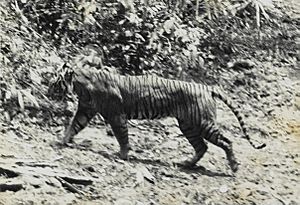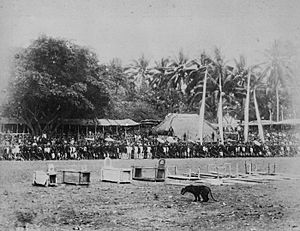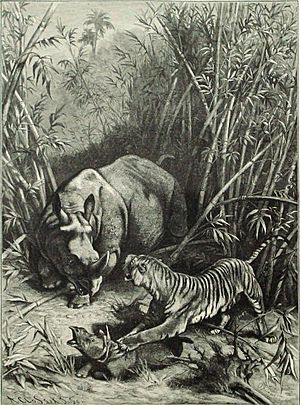Javan tiger facts for kids
Quick facts for kids Panthera tigris sondaica |
|
|---|---|
 |
|
| A photo of a Javan tiger taken in 1938 at Ujung Kulon | |
| Scientific classification | |
| Kingdom: | Animalia |
| Phylum: | Chordata |
| Class: | Mammalia |
| Order: | Carnivora |
| Suborder: | Feliformia |
| Family: | Felidae |
| Subfamily: | Pantherinae |
| Genus: | Panthera |
| Species: | P. tigris |
| Subspecies: | †P. t. sondaica |
| Trionomial name | |
| Panthera tigris sondaica | |
The Javan tiger was a type of tiger that lived only on the Indonesian island of Java. Sadly, these tigers disappeared completely by the mid-1970s. People hunted them, and their homes (called habitat) were turned into farms and buildings. The Javan tiger was one of three tiger groups found on the Sunda Islands.
For a long time, the Javan tiger was thought to be its own special tiger kind. In 2008, it was officially listed as extinct by the IUCN Red List. Later, in 2017, scientists updated how they classify cats. The Javan tiger is now grouped with the Sumatran tiger and the Bali tiger as part of the Panthera tigris sondaica group.
Scientists have studied the DNA of tiger samples from museums. They found that tigers first arrived on the Sunda Islands a very long time ago. This was during the last Ice Age, between 110,000 and 12,000 years ago.
Contents
What is a Javan Tiger?
In 1844, a scientist named Coenraad Jacob Temminck gave the Javan tiger its first scientific name: Felis tigris sondaicus. This is like its unique scientific label.
Later, in 1929, another scientist named Reginald Innes Pocock placed the tiger in the group Panthera. This is the same group that lions and leopards belong to. He used the name Panthera tigris.
In 2017, a group of cat experts decided to update the way tigers are classified. They now recognize all tigers from Indonesia, both living and extinct, as P. t. sondaica.
How Did Javan Tigers Look?

The Javan tiger was smaller than tigers found on the Asian mainland. However, it was bigger than the Bali tiger and about the same size as the Sumatran tiger. It usually had long, thin stripes. These stripes were a bit more numerous than those on the Sumatran tiger.
Its nose was long and narrow. Its skull also had some unique features. Based on these skull differences, some scientists thought the Javan tiger should be its own species, called Panthera sondaica.
Male Javan tigers were about 248 cm (98 in) long. They weighed between 100 and 141 kg (220 and 311 lb). Female tigers were smaller. They weighed between 75 and 115 kg (165 and 254 lb).
Javan tigers were smaller because of something called Bergmann's rule. This rule suggests that animals in warmer places tend to be smaller. Also, the animals they hunted on Java were smaller than the large deer and bovids found on the Asian mainland. Even though they were smaller, their paw prints were larger than those of Bengal tigers in places like Bangladesh and India.
People said the Javan tiger was so strong it could break the legs of horses or water buffaloes with its paws.
Where Did Javan Tigers Live and What Did They Eat?
Javan tigers used to live all over the island of Java. But by 1940, they had moved to remote, forested areas in the mountains. Around 1970, the last known tigers lived in the Meru Betiri region. This area was rugged and hilly, so people had not settled there.
In 1972, about 500 square kilometers (190 sq mi) of this area became a wildlife reserve. The very last tigers were seen there in 1976.
Javan tigers mostly hunted Javan rusa (a type of deer), banteng (wild cattle), and wild boar. Sometimes, they would also eat waterfowl and reptiles. We don't know how long Javan tigers lived or how long their pregnancies lasted. Before World War II, some Javan tigers were kept in zoos in Indonesia. But these zoos closed during the war. After the war, it was easier for zoos to get Sumatran tigers instead.
Why Did Javan Tigers Disappear?
People started offering rewards (called bounties) for hunting Javan tigers in the 1830s. By 1850, many villagers saw tigers as a problem. Tiger hunting increased greatly in the early 1900s. At that time, 28 million people lived on Java. There wasn't enough rice to feed everyone, so more land was cleared for farms.
Within 15 years, 150% more land was cleared for rice fields. In 1938, natural forests covered 23% of the island. By 1975, only 8% of the forest was left. The human population had also grown to 85 million people. In this crowded landscape, several things led to the Javan tiger's disappearance:
- Tigers and their prey were poisoned in many places. This happened as their homes quickly shrank.
- After World War II, natural forests were cut down more and more. They were replaced with farms for teak wood, coffee, and rubber. These new farms were not good places for wildlife to live.
- The Javan rusa, which was the tiger's main food, got sick and died in many areas during the 1960s.
- During a time of trouble in Indonesia after 1965, armed groups went into the tiger's protected areas. They killed the remaining tigers there.
Last Attempts to Save Them
In 1960, only about 10 to 12 tigers were thought to be left in Ujung Kulon National Park. Until the mid-1960s, tigers still lived in three protected areas. These areas were set up between the 1920s and 1930s. They included Leuweng Sancang Nature Reserve, Ujung Kulon, and Baluran National Parks. After the period of trouble, no tigers were seen in these places.
In 1971, an old female tiger was shot near Mount Betiri in southeast Java. This area became a wildlife reserve in 1972. A small group of guards was set up, and four projects began to help the tiger's habitat. However, two large farms in the main river valleys caused problems for the reserve. These farms were in the best areas for tigers and their prey.
In 1976, tracks were found in the eastern part of the reserve. They showed that three to five tigers might still be there. Only a few bantengs survived near the farms. But no tracks of Javan rusa were seen.
After 1979, no more tiger sightings were confirmed in Meru Betiri National Park. In 1980, experts suggested making the wildlife reserve bigger. They also wanted to remove human activities that harmed the delicate ecosystem. The Indonesian government followed these ideas in 1982. They made the reserve a national park. But these actions came too late to save the few remaining tigers.
In 1987, 30 students from Bogor Agricultural University went on an expedition to Meru Betiri. They searched the area and found tiger scat (poop) and tracks.
In western Java, there is the Halimun Reserve. Today, it is part of the Mount Halimun Salak National Park. A tiger was killed there in 1984. In 1989, paw prints the size of a tiger's were found. However, an expedition in 1990 did not find clear proof of a tiger. A new survey was planned for Meru Betiri National Park in 1992. For the first time, camera traps were used. From March 1993 to March 1994, cameras were set up in 19 places. But they did not take any pictures of a tiger. No tiger tracks were found during this time either. After this survey's final report came out, the Javan tiger was declared extinct.
Even after this, some people still thought tigers might be in Meru Betiri National Park. So, the park's chief warden started another search in 1999. With help from the Sumatran Tiger Project, 12 park staff members learned how to set up camera traps. They also used special infrared cameras. They worked for a year, but they didn't photograph a tiger. They did see some prey animals and many poachers.
Cultural Importance
In 1890, a Dutch writer named Jan Gerhard ten Bokkel wrote about how much people feared tigers. He said Javan people would never just say "tiger." They would always call it "Mister Tiger." They believed the animal might hear them and get revenge if they spoke about it too casually!
Possible Sightings
Sometimes, people who really hope the Javan tiger still exists report seeing them. These are not official reports. In November 2008, a female hiker's body was found in Mount Merbabu National Park. People said she might have died from a tiger attack. Villagers who found her body also claimed to have seen tigers nearby. In January 2009, some villagers said they saw a tigress with two cubs near a village next to Lawu Mountain. Local officials found fresh tracks there. But the animals had already left. After the Mount Merapi volcano erupted in October 2010, two villagers claimed to see a large cat paw print in the ash. This started rumors that a tiger or leopard was looking for food on abandoned farms. However, park staff nearby didn't think it was likely to be a tiger. In 2016, someone claimed to have photographed a Javan tiger on Mount Arjuno in East Java. In August 2017, a wildlife ranger photographed what they thought was a Javan tiger in Ujung Kulon National Park. But a tiger expert later said the animal was actually a Javan leopard.
See also
 In Spanish: Tigre de Java para niños
In Spanish: Tigre de Java para niños
-
- Prehistoric tigers: Panthera tigris soloensis
- Panthera tigris trinilensis
- Panthera tigris acutidens
- Holocene extinction



